نام کتاب: Nature’s Colony – Empire, Nation And Environment In The Singapore Botanic Gardens
نویسنده: Timothy P. Barnard
ویرایش: ۱
سال انتشار: ۲۰۱۶
کد ISBN کتاب: ۹۷۸۹۸۱۴۷۲۲۴۵۲, ۹۷۸۹۸۱۴۷۲۲۲۲۳,
فرمت: EPUB
تعداد صفحه: ۳۵۲
حجم کتاب: ۸ مگابایت
کیفیت کتاب: OCR
انتشارات: National University Of Singapore Press
Description About Book Nature’s Colony – Empire, Nation And Environment In The Singapore Botanic Gardens From Amazon
Established in 1859, the Singapore Botanic Gardens are arguably the most important colonial botanic gardens in the world. Not only have the Gardens been important as a park for Singaporeans and visitors, they have had a significant role as a scientific institution and as a testing ground for tropical plantation agriculture implemented around the world. As Timothy P. Barnard shows in Nature’s Colony, underlying each of these uses is a broader story of the Botanic Gardens as an arena where power and the natural world meet and interact.
Initially conceived to exploit nature for the benefit of empire, the Gardens were part of a symbolic struggle by administrators, scientists, and gardeners to assert dominance within Southeast Asia’s tropical landscape, reflecting shifting understandings of power, science, and nature among local administrators and distant mentors in Britain. Consequently, as an outpost of imperial science, the Gardens were instrumental in the development of plantation crops, such as rubber and oil palm, which went on to shape landscapes across the globe. Since the independence of Singapore, the Gardens have played a role in the “greening” of the country and have been named as Singapore’s first World Heritage Site. Setting the Gardens alongside the Royal Botanic Gardens, Kew, and botanic gardens in India, Ceylon, Mauritius, and the West Indies, Nature’s Colony provide the first in-depth look at the history of this influential institution.
درباره کتاب Nature’s Colony – Empire, Nation And Environment In The Singapore Botanic Gardens ترجمه شده از گوگل
باغ گیاه شناسی سنگاپور که در سال ۱۸۵۹ تأسیس شد، مسلماً مهم ترین باغ گیاه شناسی استعماری در جهان است. باغها نه تنها بهعنوان پارکی برای سنگاپوریها و بازدیدکنندگان مهم بودهاند، بلکه نقش مهمی بهعنوان یک موسسه علمی و بهعنوان محل آزمایشی برای کشاورزی مزارع استوایی در سراسر جهان داشتهاند. همانطور که تیموتی پی بارنارد در Nature’s Colony نشان میدهد، زیربنای هر یک از این کاربردها، داستان وسیعتری از باغهای گیاهشناسی بهعنوان عرصهای است که قدرت و جهان طبیعی در آن با هم برخورد و تعامل دارند.
باغها که در ابتدا برای بهرهبرداری از طبیعت به نفع امپراتوری تصور میشد، بخشی از یک مبارزه نمادین توسط مدیران، دانشمندان و باغبانان برای تسلط بر مناظر گرمسیری جنوب شرقی آسیا بود که منعکسکننده تغییر درک قدرت، علم و طبیعت در بین مدیران محلی و دوردستها بود. مربیان در بریتانیا در نتیجه، باغها بهعنوان پاسگاه علوم امپراتوری، در توسعه محصولات مزرعهای، مانند لاستیک و نخل روغنی، که به شکلگیری مناظر در سرتاسر جهان ادامه داد، نقش مهمی داشت. از زمان استقلال سنگاپور، باغ ها نقش مهمی در “سبز شدن” کشور داشته اند و به عنوان اولین میراث جهانی سنگاپور نامگذاری شده اند. مجموعه باغها در کنار باغهای گیاهشناسی سلطنتی، کیو، و باغهای گیاهشناسی در هند، سیلان، موریس و هند غربی، کلونی طبیعت اولین نگاه عمیق به تاریخچه این موسسه تأثیرگذار را ارائه میکند.
[box type=”info”]![]() جهت دسترسی به توضیحات این کتاب در Amazon اینجا کلیک کنید.
جهت دسترسی به توضیحات این کتاب در Amazon اینجا کلیک کنید.![]() در صورت خراب بودن لینک کتاب، در قسمت نظرات همین مطلب گزارش دهید.
در صورت خراب بودن لینک کتاب، در قسمت نظرات همین مطلب گزارش دهید.

